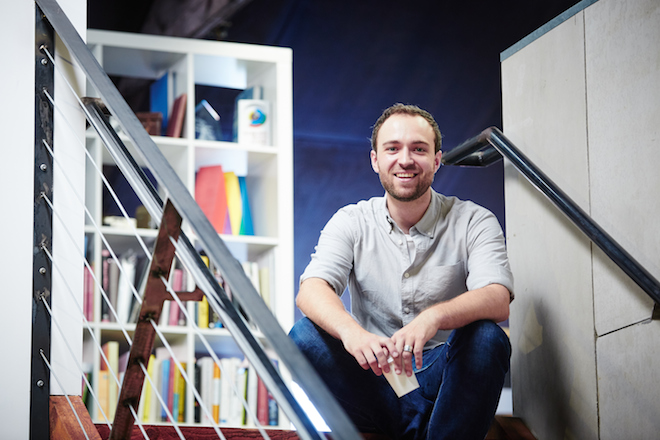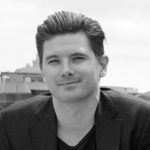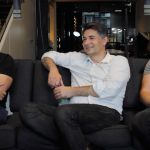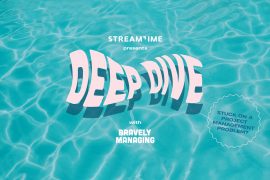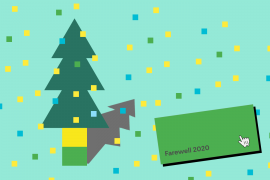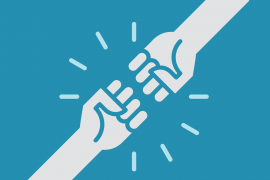Luke Kellett, is the Principal and Managing Director from Headjam, an agency that exists to stimulate change through creativity. Streamtime caught up with Luke to talk about Headjam’s creative process, their passions and the Newcastle creative scene.

Like this podcast? You can find other insightful episodes on iTunes or at streamtimeradio.simplecast.fm
Alternatively, if you’d prefer to read Luke’s insights, here’s an edited transcript of our conversation.
Change through creativity
Kye Hush: Thank you for having us in your beautiful offices here in Newcastle. Headjam, how did it start? Why did you start it?
Luke Kellett: Headjam was founded about 13 years ago, in 2002. It now has two directors, myself and my wife Sarah. We’ve really founded the agency out of a desire to work within four key sectors. We have a big passion for health and education and so we work with a lot of research organisations, work on a lot of sexual health campaigns with some fantastic clients nationally, Sydney based like AIDS Council of New South Wales, New South Wales Health and a lot of mental health organisations as well.
“It’s about producing communication solutions that try and influence behavioural change within the Australian market place in a positive way.”
It’s really about producing communication solutions that try and influence behavioural change within the Australian market place in a positive way. That’s our philosophy. A lot of our team come from an arts background so the community and arts section of our four areas are really our passion of museums, galleries and the artistic community within Australia.
We try and involve ourselves and allocate around 10% to 15% of our capacity each year to collaborate with organisations, a lot of not for profits, to help them communicate with the outside world as well. It’s a good dynamic mix.
Kye: It’s a great dynamic mix and it sounds like it’s quite rewarding too… you’re not a slave to the client as such, you’re doing work that’s rewarding, enjoyable and has a meaning.
Luke: It’s definitely rewarding, the work that we produce within health and education. It has its other set of challenges. Some of those challenges are that we’re working on absolutely minuscule budgets and for a lot of organisations, the real challenges come in terms of managing those types of workflow schedules, deadlines and trying to always punch above our weight in terms of what we’re actually delivering from a digital element or from a traditional print element. That’s probably the greatest challenge that comes in outside of the commercial element, working with those sectors, but it’s fun.

Team Collaboration
Kye: With your team here, when you get a brief from the client or a potential new client, is it a whole team collaboration or are you all specialists in your certain areas ?
Luke: That’s a good question. We’re really small and nimble, we have ten full time staff. Our team is made up of usually two developers, three designers, the creative director, two broadcast individuals that work on a lot of video production, 3D animation, editing and then a management team of myself, my account manager and also a studio manager.
“We pull on all of those multi-disciplinary roles in the studio for whatever project comes through, whether it’s small or large.”
Generally how we’ll tackle projects is we’ll tackle it as a group. That kind of philosophy just makes sure that we have lots of different opinions at that beginning ideation stage. It means that we don’t become stagnant in terms of how we’re thinking and how we’re operating. That becomes really important so we try and pull on all of those multi-disciplinary roles in the studio for whatever project comes through, whether it’s small or large.
Kye: This must be great for the team.
Luke: It’s been a real conscious effort and probably that’s a really important element for us. Just making sure that everyone in the studio knows and in the agency knows what the type of work is, what we’re accomplishing and how we’re accomplishing it. We do simple things, not only involved in the elements, but every day or every couple of days we’ll get everyone at the end of the day to stand up and do a bit of a show and tell of what they’ve been doing for that day. They’ll talk about the projects they’re on, the challenges they faced and how they’ve overcome those elements. I think that’s really important to knowledge share and make sure that everyone’s on the same page, understands what’s going on in the studio environment and that just helps bring a collaborative environment together.
Kye: Yes, definitely understanding the challenges people are facing as well because if you’re doing your own thing and you’re not aware of someone else’s, you could potentially get quite frustrated that they haven’t done their bit.
Luke: I think asking for help is a big one. Communicating to everyone, everyone has their strengths and weaknesses so it’s just about open communication and dialogue.
Kye: Communication doesn’t seem to be a particular problem for you guys here as a team. Do you find it easy to communicate with your clients? Obviously because you’ve got some government clients and small startup businesses, they’re quite different. Do you approach them the same way?
Luke: It’s always understanding expectations. It’s probably one of the key things that we try to set in place. That could be as simple as how do you want to be communicated to? Do you want emails? Do you want a phone call? It’s something we’re always working and striving to improve, but it’s a challenge.
How do you get your staff to account for their time?
Kye: We deal with a lot of clients that struggle with getting their staff to do timesheets. They’ve tried everything. Do you have that trouble or is it just an expectation?
Luke: Definitely we’ve had trouble. I think all organisations will have that… it’s a challenge. One of those elements is always that balance between business reality and the creative industry. Trying to encapsulate that and reign that into one thing is almost madness and an impossible task. Having time-tracking is a really important element, but it’s a constant challenge. We find if we have constant reminders and if we do a little name and shame exercise in terms of looking at the percentage of time based on what’s entered into Streamtime.
“It’s important and I think it’s about us educating the staff about how important it is.”
It kicks people into gear a little bit. If they’re sitting at 45%, 50%, on a Friday afternoon before we go for a beer, they might get a little stick from peers, a bit of peer pressure, a bit of gentle prodding. It’s important and I think it’s about us educating the staff about how important it is. One of the key elements that we drive home or try to communicate is that if you under track your time, we will then allocate that amount of time the next time for you and you will find yourself in a predicament where you don’t have enough time to complete the work.
Our whole business is based on the premise of looking at past jobs, looking at past invoices, making as best an educated guess as possible in terms of how long the projects will take, which is a very difficult thing to do. As you guys know, you might come up with a creative idea in 30 seconds, it might take you 30 years. Trying to quote for that requirement is quite challenging, but allowing the creative team to at least give themselves the correct amount of time and the correct amount of thinking time is really important. That’s generally our methodology, just open communication.
The Newcastle Scene

Kye: Is there a big creative network in Newcastle and would you socialise with other creative studios or is there not really that kind of culture here?
Luke: That’s a good question. Newcastle is a great creative town. One of the really interesting things if you look at Newcastle’s history is that it obviously comes from an industrial background, very blue collar working background. Not too dissimilar to other cities of the U.K. or the areas of America or Australia that have seen real growth over the years. It’s really in that transitional point where it’s finding its feet and it’s really only been in the last three years that it’s probably started to develop its own creative identity here. The city is divided in that capacity in terms of the old and the new and trying to find that direction.
There’s a great, creative community here. There’s a great series of amazing agencies, amazing small design shops and there’s some large scale advertising agencies here that work on national scale projects as well, so it’s a real boiling pot of creativity which is really exciting. We’ve made the conscious decision to try and communicate and build that culture and grow that. We moved into the building that we’re in now, with another creative agency called Mezzanine so the two brothers that run that are close friends of ours and we made the decision in terms of continuing that collaboration and knowledge share, which is really important. It might not be shared throughout the whole city, but I think in time that will happen and that’s what we hope.
What kind of clients are you hoping to attract?
Kye: You’ve told us a little bit about the kind of clients that you currently work for. Is there a domain or type of client or a particular client that you’re hoping to attract that you haven’t managed to lure in yet?
Luke: Sure. I think we are really very passionate like I said about behavioural change campaigns, whether it’s sexual health, mental health or physical activity. That becomes our primary focus, as well as collaborating with tertiary education and post-graduate education institutions throughout Australia.
We’ve been very fortunate in terms of building those relationships, but we’d like to continue to grow and collaborate with research teams around Australia, that’s a really important element for us. It’s really diverse work and it really means that we can make a real impact with the creative work that we produce, the digital work that we produce. That remains our focus and our drive.
Working with organisations throughout Australia that we really believe in or have quite a passion for is our focus as well. That’s working with startups, small local businesses or it could be collaborating with similar type businesses within Melbourne or Sydney. It’s a diverse mix, but it works really well for us. We want to keep going down that road.

Inspiration
Kye: It’s an admirable road. It’s a great road to be on. That leads me to… who or what inspires you to keep working and do what you do every day?
Luke: It’s probably, interestingly, our clients. A lot of our clients are really pushing the boundaries of what should be able to be done with the budgets that are allocated to them or what they can do with the small resources that they have. Collaborating with people that are trying to always constantly push and evolve those processes, those elements for the greater good or the development of behavioral change is really important. We take a lot of inspiration from that.
“A lot of our clients are really pushing the boundaries of what should be able to be done with the budgets that are allocated to them.”
We take a lot of inspiration from Australian design as a whole. There’s a lot of incredible work that goes on here. Whether it’s within the fashion industries, whether it’s within the printing industries or other creative agency studios, obviously, a big inspiration in that community is built. Inspiration as well is probably the latest digital technologies. So, probably one of our other strengths is that we have an internal development team and that development team means that we can accomplish a lot of different development projects and understand. Being small, we can adapt quite quickly and nimbly to changes in app development and web development, apply different methodologies and kind of move forward.
Probably the key people that inspire us there are things like Smashing Magazine in The States, anyone that’s pushing or sharing knowledge in that space and different developers, that type of thing. It’s a real mix.
Working within a tight budget
Kye: Back on budgets and small budgets, I imagine working for some government agencies, in health and things like that, the budget is small and it’s particular. Do you ever find yourselves going, “Uh, it’s pretty much a charity, should we slash our rates a little bit?” or do you try and stick to a standard rate across the board and just try and make it work, do what you can do within the budget?
“We’re going to be no good to our clients if we slashed a lot of rates and then in 12 months we don’t exist.”
Luke: I think probably the stance that we take there are… our number one priority is making sure that we can survive and exist so that we can influence this change over a long period of time. There has to be a point where we pragmatically looking at that and we’re going to be no good to our clients if we slashed a lot of rates and then in 12, 24 months we don’t exist.
Our mentality has always been that and we keep a pretty standard rate across the board. We do have two brackets of rates that we utilise and that second bracket would probably be for the research based projects, a lot of RND and there’s a lot of work that we can and hope we can get back from government initiatives as well with RND projects where we get a little kick-back from tax and things like that. They can counter that. But it’s really important for us to ensure that our hourly rates and our hours are tracked, they’re taken on as a commercial project. That’s important so that we can continue to do the work for the next decade, 20, 25, 30 years.
Kye: The reason I asked that question is, I’ve just been investigating a lot and I see this a lot, where people, particularly startups are just starting out and they want to do anything to get the work and then they’ve got a body of work and they can build on that. But they’ll do it for free or they’ll have a rate-cut, they do all this extra work that doesn’t get billed and things like that. I guess they’re making a rod for their own back because then the client will expect that all the time.
“It’s really important for us to ensure that our hourly rates and our hours are tracked, they are taken on as a commercial project.”
Luke: Yeah, you’re right. I think that we’ve been around for 13 year so we definitely went through what I would describe in that capacity as growing pains of some capacity throughout that period of time. If you under quote, if you under-bill once, that’s the expectation level. It’s really important for us to make sure that that’s really nice and clear and upfront, just making sure that we’re on the same page.
If we ever do do work pro bono and there will always be an associated quote and invoice sent to the client for example, that outlines what has been provided in terms of the hourly rate, the total cost of what that would have cost in the commercial sense. I think again that’s really important for the expectations so that they understand what’s being provided.
We’ve started doing really basic things like creating memorandums of understanding, what we’re getting out of the relationship, what the client wants out of the relationship, if we ever do do work at a discounted rate. The majority of the time our rates mean that we have a price point that we can work with these type of organisations and they also understand that they want us to be here in more than five years.
Best piece of advice
“Your entire career will be defined by the times you say no”
Kye: Finally I’d just like to finish off with, what’s the best piece of advice you’ve ever been given?
Luke: This is a good one. I have one for this. This was given by a photographer that I used to work for when I was an assistant in the U.K. She was called Sarah Mango. She told me that my entire career would be defined by the times you say “no” and that is incredibly true. We carry that on today in terms of turning down a lot of work and making sure that the work we do take on is the work that we want to produce.
Kye: That was a wonderful piece of advice. I might take that on board too. Thank you for sharing it with us and thanks for having us in your studio today.
Luke: No worries, thanks for coming.
Images courtesy of Headjam.


